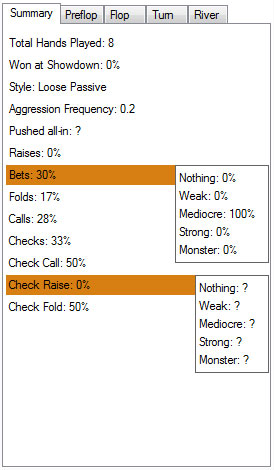| wiki | search |
Hand Rating is one of the key features that makes Poker Muck unique. But you need to understand how it works before you draw the wrong assumptions about your opponents.
How it works
Knowing the frequency of the actions of a player is only half the work. The other half needs to answer the question "What does a particular action mean?".
Each action (bet, raise, call, check, check-raise, check-fold, check-call) of a player is examined at showdown and rated preflop and on each street. Then averages for each street are averaged and displayed in the Summary tab of the statistics (you can still look at each individual phase through the tabs if you want to break it apart).
| Strength | Preflop | Postflop |
|---|---|---|
| Nothing | In the lower 50th percentile of starting hands | High card and no draws |
| Weak | Between the 25th and 50th percentile of starting hands | High card and flush or straight draw, bottom and middle pair with no draws |
| Mediocre | Between the 10th and 25th percentile of starting hands | Middle pairs with draws, top pairs with no draws |
| Strong | In the upper 10th percentile of starting hands | Top pair with draws, top pairs with high kicker, two pairs |
| Monster | No hands classify as monsters preflop. | Three of a kind and higher |
Beware of the numbers
Although information calculated in this manner is useful to better understand the meaning of a particular action, you should threat it very carefully, as the numbers will tend to be inflated. Here's why:
We can rate only hands that reach showdown. This does not account for all the hands that end preflop or during one of the streets. A player might easily shoot three bets preflop, on the flop and on the turn, but if he folds at the river we will never know if he really had a hand or if he was bluffing. This will inevitably tend to show our opponents as betting and raising with strong and monster hands. Whenever you read a statistic such as:
| Nothing: | 0% |
|---|---|
| Weak: | 0% |
| Mediocre: | 10% |
| Strong: | 80% |
| Monster: | 10% |
Remind yourself that the percentage is calculated on the total of hands for which we were able to see the player's cards. This does not include all the times where the player bet with nothing and folded on the flop, turn or river. Statistics only show the information we have at our disposal, but their interpretation can be misleading. If you understand this, you can use these information more accurately.

